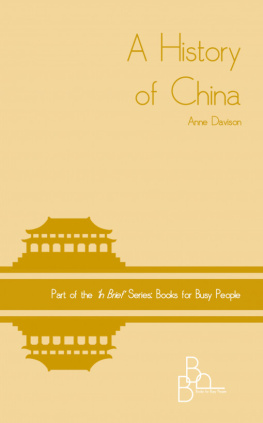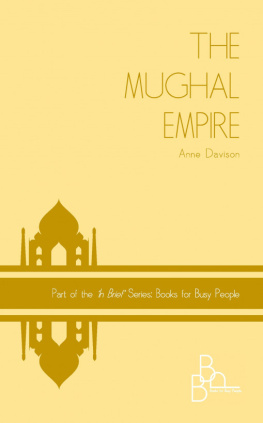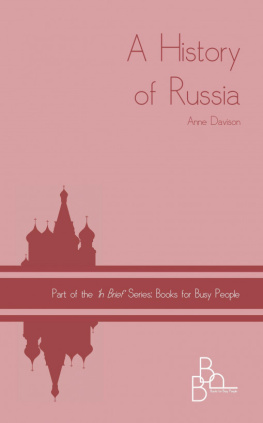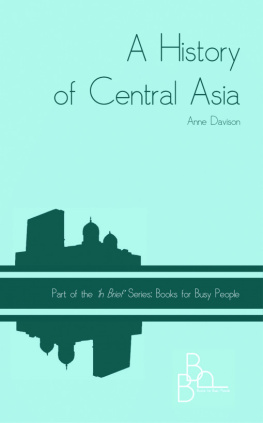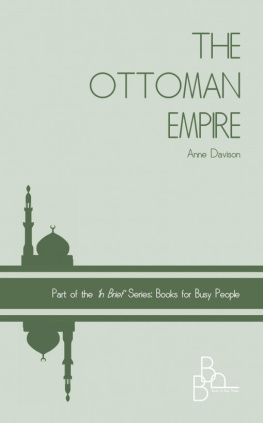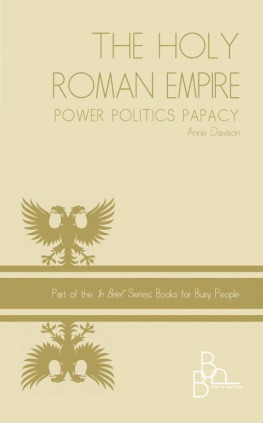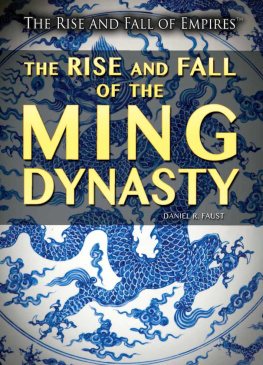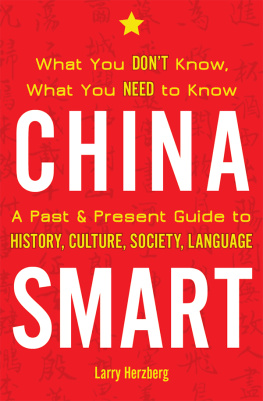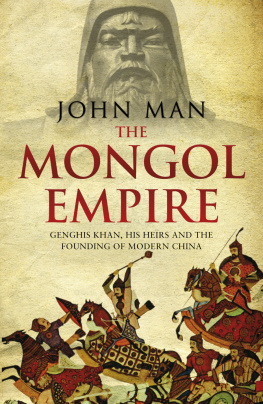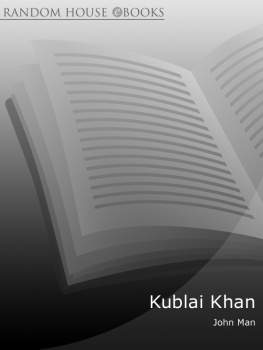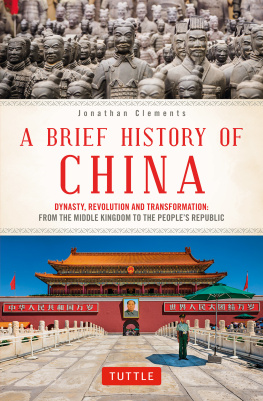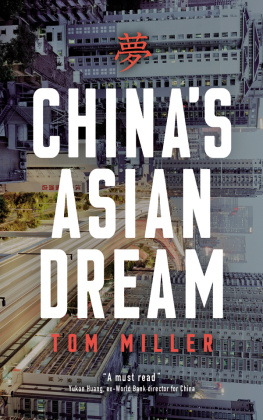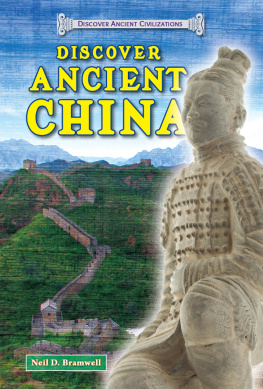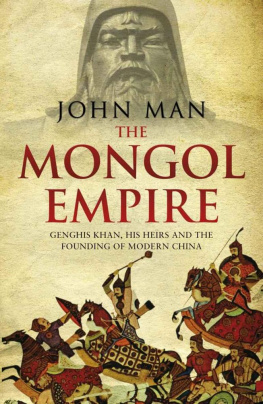A History of
CHINA
In Brief:Books for Busy People
by Anne Davison
Copyright2019 Anne Davison
Smashwords Edition
This ebook is licensed for your personal enjoymentonly. This ebook may not be re-sold or given away to other people.If you would like to share this book with another person, pleasepurchase an additional copy for each recipient. If you're readingthis book and did not purchase it, or it was not purchased your useonly, then please return to Smashwords.com and purchase your owncopy.
Thank you for respecting thehard work of this author

Cover Design by Karen Turner
OTHER BOOKS BY THE SAME AUTHOR
A History of Central Asia
A History of Russia
Abrahams Children: Jew, Christian, Muslim;Commonality and Conflict
From the Medes to the Mullahs: a History ofIran
Making Sense of Militant Islam
Paul of Tarsus: a First Century Radical
The Holy Roman Empire: Power PoliticsPapacy
The Mughal Empire
The Ottoman Empire
http://www.inbriefbooks.com
*****
CONTENTS
MAPS
Map ofChina
The FiveDeities
Battle ofBanquan
The FiveEmperors/First Dynasties
The ShangDynasty
The SevenWarring States
The XiongnuEmpire
EmperorGaozu
The ThreeKingdoms
MajorChinese Empires
Spread ofBuddhism
Tang DynastyFamily Tree
TangEmpire
Genghis KhanFamily Tree
MongolEmpire
Qing Period KeyDates
Qing FamilyTree
Republican ChinaKey Dates
CommunistChina Key Dates
NapoleonBonaparte, when referring to China, famously said; China is a sleeping giant. Let her sleep,for when she wakes, she will shake the world. His words were prophetic. For centuries China slumbered.Then, about forty years ago she woke up and since that time hasrisen to become the worlds second largest economy by GDP, with theworlds greatest purchasing power.
This book tells the story ofChinas long history. To attempt this in under 200 pages isadmittedly ambitious. But this is the aim. In common with othertitles in the In Brief series, the book is written for thegeneral reader who does not have the time, or inclination, to reada heavy academic tome. It gives an overview of Chinas complexhistory in an accessible and informative style, with maps, chartsand timelines to help the reader navigate through the text.
Starting withthe pre-historical Yellow Emperor, the earlier chapters traceChinas major dynasties, including the Han, Tang and Ming. Twiceduring its long history, the country was ruled by non-Chinesedynasties: the Mongol Yuan between the 13 th and14 th Centuries and the Manchu Qing, the last of the imperialdynasties, that ruled between the 17 th and20 th Centuries. The later chapters cover the decline and fall ofthe Qing, the Republican era and finally CommunistChina.
Writing any history book isheavily dependent upon available sources. There are very fewwritten records for the earlier period and they are not necessarilyreliable. Very often the manuscripts have been written decadesafter the events occurred. Also, scholars have argued that factshave been inserted into the original text, perhaps for politicalreasons. This was particularly true during the earlier centuries ofImperial China when court historians were commissioned to write anofficial history that generally portrayed the commissioningEmperor in a favourable light compared to the preceding ruler.
Unfortunately, some of theearly written records of Chinas history have been lost ordestroyed. In about 200 BC, the first Emperor of the Qin Dynasty issaid to have ordered the burning of undesirable books and as lateas the Cultural Revolution, between 1966 and 1976, certainhistorical books were banned and often destroyed.
An added disadvantage for thisparticular author is that while there is a wealth of materialwritten for the Chinese reader, very little of the early materialhas been translated into English. However, with modern technology,we now have tools other than the written word. For example, withthe help of drones and special cameras, we now have other tools fordiscovering the past. Of course, what we see, often on ourtelevision screens, is still open to interpretation by theexperts, be they guides, academics or TV presenters.
Today we are overwhelmed withinformation. This presents a different challenge. We have to siftthrough vast amounts of material, much of which may be suspect. Intodays world of fake news, much of this may well be fakehistory.
In writing this book, my aimhas been to use reliable sources wherever possible. Equally I hopethat I have pointed out the need for a critical reading. Forclarification, I have used BC and AD for the first two chapters.Thereafter, AD has been dropped unless needed.
An added confusion can arisewith place names. For example, todays Beijing was known asKhanbaliq in the Mongol Yuan period (1271-1368) and Peking at thetime of the Qing (1644-1912). And todays Xian was known asChangan during the Tang Dynasty (618-907).
While there will inevitably begaps in a work of this size, it is hoped that the reader may beinspired to further reading on the subject. For those interested, ashort selection of the main works that have been consulted isprovided at the back.
Finally, I would like to thankthose friends and colleagues who have given of their time to readthrough various chapters, to proof read the script, as well as tooffer helpful comments.
*****
Ancient Period: 2698-256 BC
China, with thousands of yearsof continuous history, is one of the oldest civilisations in theworld and is regarded as a cradle of civilisation. A well-knownexample of its early habitation is the discovery in 1923 ofskeletal bones and stone tools near Beijing. These remains areestimated to be between 680,000 and 780,000 years old. In 1923, atthe time of the discovery, Beijing was known as Peking, hence thefind became known as Peking Man.
Carbon dating provides evidenceof rice cultivation in the Yangtze River region as far back as8,000 years and cliff carvings from the same period show scenes ofhunting and fishing as well as a possible form of early writing.Archaeologists have also discovered remains of buildings andpottery along the Yellow River basin, which suggests thatsettlements existed as far back as 5,000 BC.
Ancient Texts
The firstwritten records of Chinese history date back to around 300 BC inthe form of chronicles that were recorded on bamboo or woodenpanels. These panels were then bound together in bundles of aboutthirty. The best-known texts are the Bamboo Annals and the Records of the Grand Historian.
Althoughthe Bamboo Annals were not written until around 300 BC, the author starts hishistory many centuries earlier with the legendary Yellow Emperor,who was said to have ruled between 2698 and 2598 BC. Since therewere no written records going back so far, the author relied onoral folklore and myth. Consequently, the line between fact andfiction for this early period of history is blurred.
The Bamboo Annals relate thehistory of dynasties and events up to 299 BC, which was during thetime of the Zhou Dynasty. The original text was buried with KingXiang of Wei in 296 BC. Over five centuries later, in 279AD,fragments of the Annals were discovered after a robber broke into theKings tomb.
Today thereare two versions of the Annals : an ancient text that hasbeen pieced together from the original text, and a current textthat was compiled in the 16 th Century. Since that time,there has been ongoing debate regarding the authenticity of thecurrent text. The majority view tends towards the reliability ofthe earlier version over the current text.

